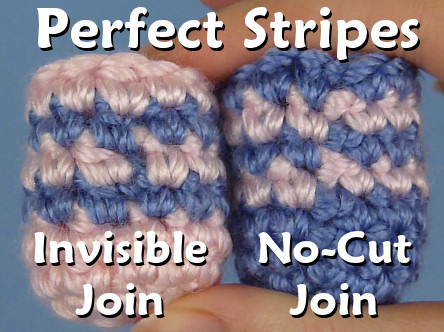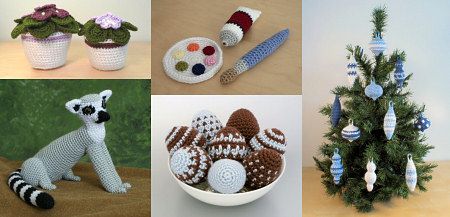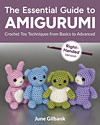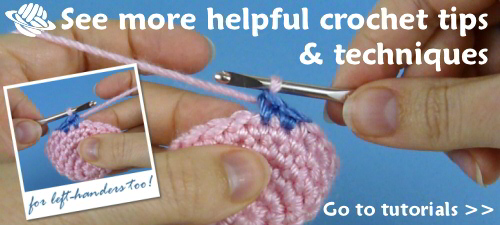Perfect Stripes for Amigurumi [video]
The No-Cut Join below is still a very good option for situations where you’d prefer to not cut the yarn between rounds. You can compare all three methods for yourself in my amigurumi stripes comparison post.)
I’ve developed two methods you can use to minimise the seam when you work in joined rounds to make stripes for amigurumi (or anything else that’s single crocheted in the round). As these joins don’t travel or require extra stitches, you can just add the join of your choice between rounds in any striped single crochet pattern (whether it was designed to be worked in continuous spirals or joined rounds). You don’t need to modify your stitch count; they just work.

Where’s the seam, you ask? That’s exactly the point!
Let’s jump straight to the video, and then I’ll give you a rundown of the strengths and weaknesses of each method.
Perfect Stripes for Amigurumi (right-handed)
Click to watch this video on YouTube.
Perfect Stripes for Amigurumi (left-handed)
Click to watch this video on YouTube.
Note: The videos may look a little small embedded in the blog: if so, you can fullscreen them or click through to YouTube to watch them full-sized 🙂
Method 1: Invisible Join
Pros: doesn’t travel, totally invisible
Cons: slower, must cut yarn between stripes, lots of yarn ends on back
Best choice for: stuffed amigurumi where the back will be hidden inside the piece
Method 2: No-Cut Join
Pros: doesn’t travel, no need to cut yarn, no yarn ends on back
Cons: not completely invisible
Best choice for: joined rounds with no colour change between rounds; hats etc where the inside of the piece will show; people in a hurry!
My Recommendation: Hybrid Method
The Invisible Join (as the name suggests) gives a slightly better finish, but the No-Cut Join is faster and less fiddly, so I recommend using a combination of the two for any pattern where you need to single crochet in joined rounds and/or make stripes. I recommend:
- For rounds where you’re changing colour, finish the round and start the new round with the Invisible Join.
- For rounds where you’re continuing with the same colour as the previous round, finish the round and start the new round with the No-Cut Join (there’s no point in cutting the yarn and immediately starting again with the same yarn!)
- If you have a big chunk of one colour – lot of rounds with no colour changes – you may want to save time by spiralling around those rounds, and then changing to joined rounds at least one round before the colour change.
(To change from a spiral to joined rounds, just use the end of round instructions from the No-Cut Join – or the Invisible Join if you prefer – at the end of your last spiral round. You’ll have a slight glitch there, but you may prefer it to making a No-Cut Join every round for e.g. 20 rounds…)
Video Quick Links
Looking for a quick video refresher on the method you want to use? Jump straight to the part you need:
- Invisible Join (right-handed)
- No-Cut Join (right-handed)
- Comparison (right-handed)
- Invisible Join (left-handed)
- No-Cut Join (left-handed)
- Comparison (left-handed)
Written Instructions
I do recommend you watch the above video to see the methods in action, but in case you prefer text or want something to refer to, here are written instructions for each method too.
Invisible Join Method:
START OF ROUND: Make a slip knot on your hook. Sc in first st (the duplicated stitch from the previous round) and in each st around.
END OF ROUND: Cut yarn leaving a 2″ tail. Draw up last loop to pull cut end through to the top. Now we’re going to duplicate the loops at the top of the first stitch, to close the round and hide the join:
- Insert hook from back to front under both loops of the 2nd stitch of the round, yarn over and draw cut yarn end through to the back.
- Insert hook from back to front under the back loop of the last stitch of the round, yarn over and draw cut yarn end through to the back.
- Optional: to keep the duplicate stitch tight, tie both ends together on the back of the work.
No-Cut Join Method:
START OF ROUND: Ch 1. Sc in first st (the same stitch you drew yarn through at end of previous rnd). Sc into each st around.
END OF ROUND: Remove hook from loop. Insert hook from back to front under both bars of first stitch of round. Put loop back onto hook and draw through to the back. Pull loop tightly to draw stitches together, then pull working yarn to draw loop back to usual size.
And, if you’re changing colour, the magic colour change point is at the very beginning of each round – you’ll change colour with the ch 1 at the start of the new round.
Use in Amigurumi Patterns
You can safely use either technique for any of my patterns that use stripes in joined rounds (e.g. African Violets pot, Ring-tailed Lemur tail); instead of fastening off between colours for the Ami Paint Set brush and paint tube, or instead of the optional joined round modification given in my other striped patterns, Easter Eggs and Christmas Baubles.

You can also substitute one of these joins for a normal join to give you neater stripes in any other amigurumi pattern, or to add stripes to any amigurumi (it’s the stripe equivalent of substituting invdec for a sc2tog: it will work in almost every case). These joins will improve the appearance of striped hats too, or any other pieces single crocheted in the round!
***
If you enjoy my crochet tutorial videos, please help to spread the word about them, and/or subscribe to the PlanetJune YouTube channel.
Loved this tutorial? I have so many more amigurumi tips and tricks to share with you!
Boost your amigurumi skills with my latest book, The Essential Guide to Amigurumi, your comprehensive guide to amigurumi techniques and tips.
Do you find my tutorials helpful? If so, please consider making a contribution towards my time so I can continue to create clear and concise tutorials for you:
Thank you so much for your support! Now click below for loads more crochet video and photo tutorials (and do let me know what else you’d like me to cover in future tutorials…)


















Jane C said
Hello, I’m loving the joining methods and have been using a mixture of cut and no-cut joins as suggested. However, your joins seem to stack in a nice straight line whereas mine slant to the right going up the work. The joins are lovely and straight horizontally but the slight bump of the join makes an obvious line to the right. What am I doing wrong? Any advice would be much appreciated. Many thanks.j
June said
Without seeing your work, it’s hard to say for sure, but you’re probably not doing anything wrong, Jane! Unless your stitches are jumping by a whole stitch width in every round (which would mean you’re not making the correct number of stitches to complete the round), you’re probably just seeing the natural drift of your stitches. Amigurumi-style crochet always has a skew (as each stitch sits slightly behind the same stitch on the round below), so a vertical line of stacked stitches will never be vertical; it’ll always slant backwards. And that appears more obvious when you have a seam that’s slanted instead of vertical.
If this bothers you and you’d prefer an absolutely perfect result, I recommend my newer Ultimate Stripes technique instead. You do need to cut the yarn with every single round (even if you’re not changing colour!) but you’re guaranteed a completely invisible seam and perfect result.
June said
Great! These are specifically methods for amigurumi with multiple bands of colour where you’re changing colour every round or two and want the best match between the ends of the colours – you could absolutely use your method for longer stretches of the same colour (or for every round, if that’s what you prefer) 👍
Karla said
Okay, here is a much easier method to get really invisible joint rounds in the same color: Close the round with a slip stitch as usual. Don’t chain 1! Instead pull the loop on you hook just a little bit higher and go on with the sc.